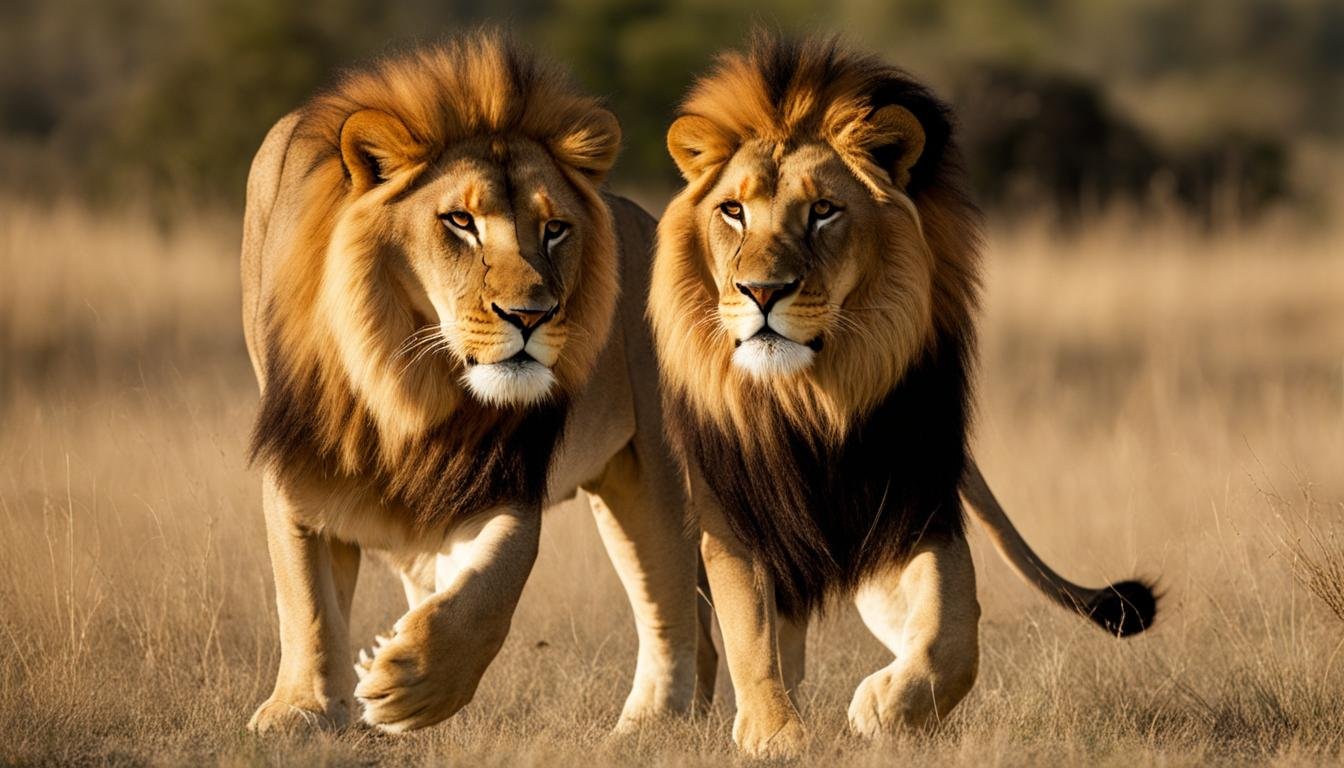Male vs Female Lion: Key Differences Explained
Have you ever wondered what the differences are between a male lion and a female lion?
Although they look similar at first glance, male and female lions have several notable differences that set them apart.
From their physical appearance to their behavior and social structure, understanding these differences can provide greater insight into the fascinating lives of these majestic creatures.
Key Takeaways:
- Male and female lions have different physical characteristics, behaviors, and roles within the pride.
- Male lions are typically larger and have manes, while females are smaller and lack manes.
- Male lions tend to be more territorial and play a larger role in protecting the pride, while females are more involved in raising the cubs.
- Lion prides have a complex social structure that involves cooperation and conflict between males and females.
- Males and females also have different hunting roles and techniques that depend on their size, strength, and agility.
Physical Differences Between Male and Female Lions
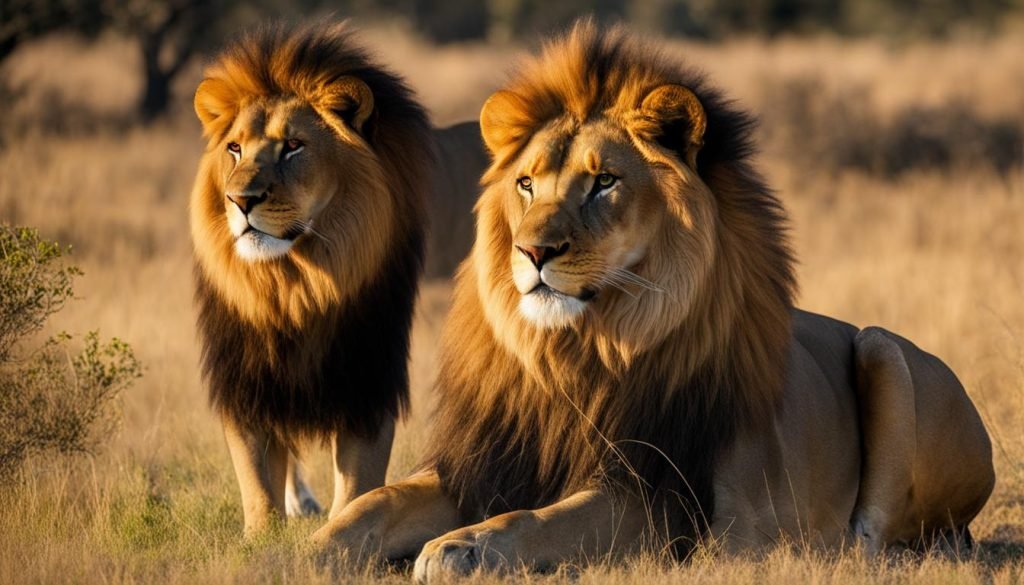
Male and female lions differ in various physical characteristics that help to distinguish each gender. Here, we will examine their physical distinctions, including their size, mane, body shape, and other prominent features.
| Gender | Average Weight | Average Length | Mane Appearance |
|---|---|---|---|
| Male | 330-550 lbs | 5.6-8.4 ft | Dark, thick, and lush; covering their entire head, neck, and upper chest. |
| Female | 260-400 lbs | 4.6-6.3 ft | Lighter, thinner, and sparser; either shorter or absent on the head and chest. |
Male lions are typically larger than females, with longer, heavier bodies. They can weigh up to 550 pounds and reach up to 8.4 feet in length, while females can weigh up to 400 pounds and reach 6.3 feet in length.
One of the most notable physical differences between male and female lions is their mane. Male lions have a thick, dark mane that covers their head, neck, and upper chest, while females have a lighter, shorter, and sparser mane or no mane at all. The mane serves to attract females and intimidate rival males, reflecting the male lion’s dominant position in the pride.
In addition to mane and size, male and female lions differ in body shape and structure. Males are more muscular and have a larger head, while females have a more streamlined physique. These features are not purely coincidental, as they reflect the unique roles and responsibilities that each gender assumes within the pride.
Male and female lions have several physical characteristics that allow them to thrive in their natural environment. Understanding these differences can provide valuable insights into the various roles that each gender plays in the pride’s dynamic social structure.
Male vs Female Lion: Size Differences
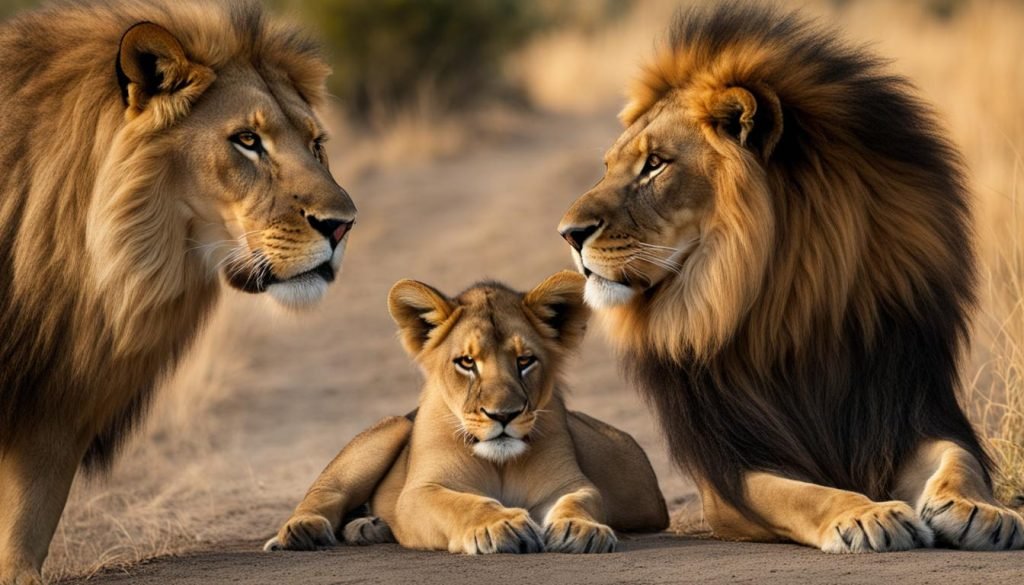
Lions are the second-largest big cats on the planet, after tigers. However, there is a noticeable size difference between male and female lions. Males tend to be significantly larger and heavier than females, with a more robust and muscular build.
The average weight of a male lion is around 190-205 kg (420-450 lb), while females usually weigh between 125-165 kg (275-360 lb). In terms of length, males are between 2.7-3.3 m (9-11 ft) from head to tail, while females are slightly shorter, measuring 2.4-2.7 m (8-9 ft).
These variations in size can be attributed to the different roles that males and females play within the pride. Male lions are responsible for hunting and protecting the pride, so their larger size and strength are crucial for these tasks. Females, on the other hand, are primarily responsible for raising cubs and cooperating with other females to take down prey.
The Mane: A Mark of Masculinity
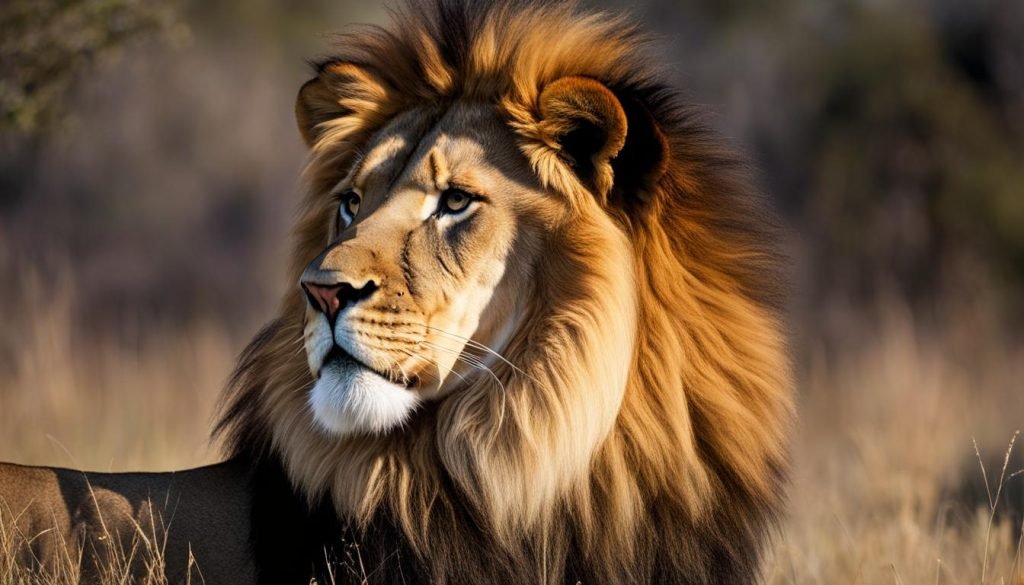
The male lion’s mane is one of the most distinguishing physical traits of this species. It is a thick layer of hair that surrounds the neck, chest, and shoulders, giving male lions a regal and impressive appearance. The mane is often used as a sign of dominance, marking the male lion’s status as the leader of the pride.
Manes can vary in color, with some being dark brown or even black while others are light in color and almost yellow. The color variation is influenced by genetics, environment, and age. Younger males usually have thinner, shorter, and lighter-colored manes, while older males tend to have darker, denser, and thicker manes that can reach up to a foot in length.
The development of the mane is linked to male lion characteristics such as age, testosterone level, and genetics. Testosterone production promotes mane growth, and high levels of testosterone are usually associated with bigger and darker manes. However, not all male lions have a mane, as some may have less testosterone and therefore develop only a partial or nonexistent mane.
“The mane’s size, color, and density signal a male lion’s strength and power, helping him attract females, intimidate rivals, and protect his pride.”
Body Shape and Structure
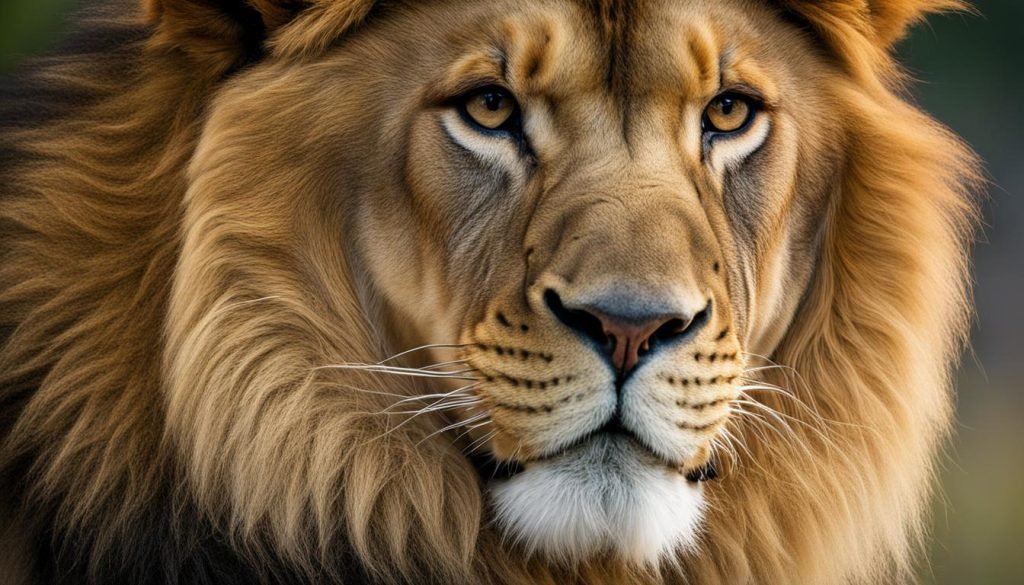
Male and female lions have markedly different body shapes and structures. Generally, males are larger and more muscular than females, with more prominent bone structure and greater total body mass. Female lions tend to have a more streamlined appearance, with a smaller head and slimmer body.
The size difference is most apparent in the head, where male lions have a larger skull and longer snout. This difference is attributed to the male’s role in hunting and fighting and his need for a stronger bite force. Female lions, on the other hand, prioritize speed and agility in their hunting techniques and therefore have a more streamlined head structure.
Another key difference is the shape and size of the paws. Males have larger paws with retractable claws, ideal for grappling with prey and combat, while females have smaller, less robust paws.
When it comes to muscularity, male lions have a more defined musculature, with a more prominent neck and muscular forelimbs, indicating their superior strength and agility in hunting and combat. Females, on the other hand, have less developed muscles in these areas, making them more nimble and faster runners.
In summary, male and female lions exhibit marked differences in their body shape and structure, with males being larger and bulkier, while females have a more streamlined appearance. These physical differences reflect the different roles and priorities of each gender in the lion pride.
Behavioral Differences Between Male and Female Lions
Male and female lions exhibit marked differences in their behavior, which are largely a result of their distinct biological roles within the pride.
| Behavior Traits | Male Lion | Female Lion |
|---|---|---|
| Hunting Patterns | Male lions are typically responsible for hunting larger prey, using their strength and size to overpower animals such as buffalo and giraffes. | Female lions generally hunt smaller prey, relying on their speed and agility to capture animals such as gazelles and impalas. |
| Territoriality | Male lions defend the pride’s territory against rival male lions and other threats, often marking their boundaries through vocalizations and scent. | Female lions assist in protecting the pride’s territory and act as defenders of their cubs, but their roles in territorial defense are less pronounced than those of male lions. |
| Social Hierarchy | Male lions occupy the highest ranks within the pride, with dominant males enjoying exclusive mating rights and social status within the group. | Female lions establish their own hierarchy within the group, with dominant females typically exerting significant influence over the pride’s social dynamics and decision-making processes. |
| Roles Within the Pride | Male lions play a critical role in protecting the pride against threats and securing the group’s survival through their mating activities and territorial defense. | Female lions perform numerous tasks within the pride, including hunting, rearing cubs, and contributing to territorial defense, supporting the group’s overall welfare. |
The behavioral differences between male and female lions are also reflected in their vocalizations and communication patterns. Male lions are known for their distinctive roar, which serves as a mechanism for communicating with other lions within their territory and potentially warding off potential attackers. Female lions, on the other hand, engage in a wider range of vocalizations, including growls and purrs, which are used for communication both within the pride and during hunting activities.
Hunting Roles and Techniques
Male and female lions have distinct hunting roles and techniques that allow them to work together to bring down prey.
| Hunting Tactics | Male Lions | Female Lions |
|---|---|---|
| Stalking | Less Common | More Common |
| Ambushing | More Common | Less Common |
| Chasing | More Common | Less Common |
Male lions typically specialize in ambushing and chasing prey. Their large size and muscular strength allow them to overpower prey, while their distinctive manes may serve as intimidation to create fear in potential victims. Female lions, on the other hand, excel in stalking and attacking prey. Their smaller size and greater agility allow them to sneak up on prey more easily and launch a surprise attack.
Both male and female lions cooperate to hunt and take down larger prey. They use a “teamwork” approach, with some lions scaring the prey toward other lions waiting in ambush. They also take turns attacking and resting, allowing one group to rest while the other attacks, ensuring that it takes their prey by surprise.
Hunting is essential for the survival of lion prides, and each member plays a critical role in the success of the hunt. Next, we will examine the social structure and roles within lion prides, providing insights into one of nature’s most fascinating ecosystems.
Social Structure and Roles Within the Pride
In addition to physical differences, male and female lions have distinct social structures and roles within their pride. Pride is a group of lions that live and hunt together. The average pride size is between 15 to 20 lions, consisting of several adult females, their offspring, and one or more adult males.
Females play a significant role in lion society, being responsible for the majority of the pride’s hunting and raising the cubs. Female lions also establish and defend the territory of the pride. As a result, they exhibit a cooperative hunting strategy involving teamwork, stealth, and speed.
On the other hand, male lions occupy a dominant role within the pride, mainly as protectors and as a means to ensure survival and expansion. Male lions defend the territory from other predators and rival male lions, using their strength and size to intimidate and fight off opponents.
Although male and female lions play various roles in their pride, they also interact frequently, engaging in grooming, playing, and even mating. The complex social order within the lion pride is crucial to its survival and reflects the behavioral adaptations that have evolved over millions of years of coexistence.
| Female Lions | Male Lions | |
|---|---|---|
| Main Role | Hunting and raising cubs | Protecting and expanding the territory |
| Social Hierarchy | Based on age and dominance | Based on physical strength and dominance |
| Reproductive Role | Mating with dominant males for cubs | Mating with multiple females |
The interactions between male and female lions result in a complex social hierarchy where females dominate the maternal aspects while males dictate the territorial and protective functions. Understanding the social structures and behaviors of male and female lions is fundamental to comprehending their unique characteristics and further studying their survival mechanisms in the wild.
Vocalizations and Communication
Male and female lions use various vocalizations and body language to communicate with each other and other animals in their territory. The typical roar of a male lion can be heard from a distance of 5 miles and is often used as a territorial warning to other male lions. The roar of a female lion is shorter and less powerful than that of a male lion.
Growling is another common vocalization used by both male and female lions, often as a warning or a sign of aggression. When they are communicating with their cubs, lions use different types of purrs, which signify caring and comfort. Experts say that lions also use a range of non-vocal communication signals such as facial expressions and body posture to express emotions and intentions to other pride members.
Interestingly, while male lions roar more frequently than their female counterparts, it is the females who often direct communication and organize collaborative efforts between pride members. This could be attributed to the fact that female lions spend more time with their cubs and are more adept at ensuring their survival by negotiating and collaborating with other lionesses in the pride.
“Lions are incredibly social animals and rely heavily on vocalizations to communicate. Roaring, growling, and purring are just some of the various sounds and expressions that form part of their complex communication system.”
Vocalization Differences between Male and Female Lions
| Gender | Vocalization |
|---|---|
| Male | Territorial roar |
| Growling | |
| Female | Shorter roar |
| Purring |
Reproductive Differences
Male and female lions exhibit distinct reproductive behaviors and patterns. Mating is essential for the survival and growth of the pride, and each gender plays a crucial role in the process.
Male Lion Behavior: Male lions are known for their polygamous habits, often mating with several females within the pride. They reach sexual maturity between 2-3 years of age and remain fertile throughout their lives. Dominant males often fight for the right to mate with females within the pride, and their victory guarantees their access to females and increases their chances of passing their genes on to the next generation. Male lions are also known to participate in infanticide, killing the cubs of rival males to increase their likelihood of siring future offspring.
Female Lion Behavior: Female lions reach sexual maturity between 2-3 years of age and typically mate with dominant males within the pride. They give birth to cubs after a gestation period of around 110 days, usually delivering 2 to 3 cubs at a time. Lionesses within the pride will often synchronize their reproductive cycles to take advantage of communal cub-raising. They are the primary caregivers and protectors of the cubs and will fiercely defend them from any danger.
During the breeding season, which typically occurs between August and October, male lions will increase their mating activities, and females become more receptive to their advances. Lionesses are the ones who initiate mating by exposing their hindquarters and rubbing against the males. The process of mating itself takes only a few seconds, and couples can repeat the act multiple times per hour over several days.
While both male and female lions play critical roles in reproducing and ensuring the survival of their species, they exhibit distinct behaviors that differ in terms of mating, parenting, and territoriality. Understanding these differences can help us appreciate the unique traits and adaptations of these magnificent animals.
Conclusion
Male and female lions exhibit several key differences in physical characteristics and behavioral traits. While male lions are generally larger and possess a prominent mane, female lions are often leaner and more agile. In terms of behavior, male lions tend to be more territorial and have specific roles within a pride, while female lions are more adept at hunting and raising cubs.
Understanding these lion gender differences is crucial for wildlife researchers and enthusiasts seeking to learn more about these majestic creatures. By delving into the intricacies of lion behavior and anatomy, we can gain deeper insights into their unique contributions to the animal kingdom.
Whether you’re planning an African safari or simply fascinated by the natural world, the contrasting features of male and female lions are sure to captivate your attention and leave you in awe.
More About Lions:
- How Many Lions Exist in the World in 2024?
- How Long Do Lions Live? Wild vs Captivity
- Do Lions Eat Humans?
- What Do Lions Do All Day?
- What Do Lions Do During the Night?
- Where Do Lions Sleep?
- Can Lions Swim? Lion’s Swimming Ability Examined
- Cannibalism in Lions: Do Lions Eat Other Lions?
- Do Lions Hibernate During Winter?

